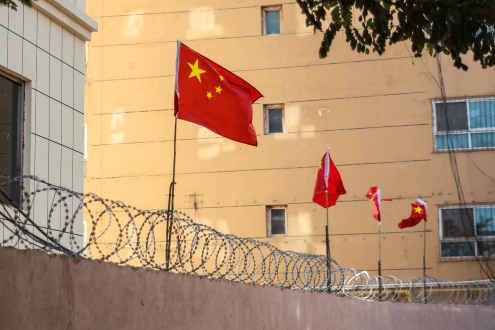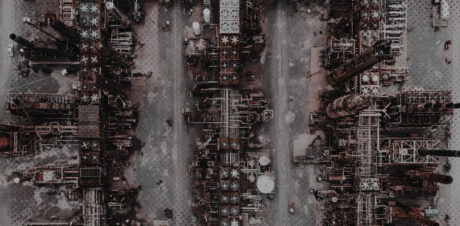Last month, we reported on the sprawling holdings of the OFAC-sanctioned Xinjiang Production and Construction Corps (XPCC), a massive Chinese conglomerate with hybrid paramilitary-corporate structure. The XPCC was sanctioned for its alleged involvement in human rights abuses against ethnic minorities in China’s Xinjiang Uyghur Autonomous Region (XUAR).
This follow-up analysis and accompanying dataset are designed to help compliance teams quickly triage risk, focusing specifically on 4,000+ legal entities (e.g. companies limited by shares, LLCs, partnerships, factories, etc.), plus their branches, that are branded entities of the XPCC or solely owned by the XPCC and its subordinate divisions, regiments, and components.
Each of the 4,000+ entities contains, where available, name (CN), name (EN), machine translation of Chinese name, address, identifiers, operating status, ownership path, and a link to the expanded profile and sourcing in Sayari Graph.
Key Findings
- Understanding the XPCC’s structure is crucial for compliance. The XPCC has a complex structure and, like many Chinese government bodies, owns entities both directly and through multiple subordinate vehicles.
- The XPCC’s ownership of legal entities is not always obvious. This dataset contains 1,000+ entities that do not have “XPCC” in their names and 50+ entities based outside Xinjiang. Additionally, since the July 31 OFAC designation, some entities have changed their names to no longer include “XPCC,” while others have changed their ownership from the XPCC itself to a non-branded subsidiary.
- This dataset represents a fraction of the XPCC’s highest-risk holdings. We used Chinese public records to identify branded XPCC entities and entities wholly owned by the XPCC and its subordinate divisions, regiments, and components. There are almost certainly many other entities that meet the majority ownership risk threshold, both in China and abroad; these will be the subject of future analysis.
Methodology
In China, legal entities may only use the name of a government agency if they are owned by that government agency or one of its components. In order to capture all the possible “branded” XPCC entities, both public and private sector, we first ran a query in our database of Chinese public records for all registered entities whose name contained an exact match to the characters for “Xinjiang Production and Construction Corps” (“新疆生产建设兵团“), which returned over 3,400 deduplicated matches. Note that we did not specifically include Chinese-language abbreviations for “XPCC” (e.g. “建设兵团” or “兵团“), which would likely increase the total number of branded entities.
In addition to these branded entities, we wanted to capture all companies that did not contain “XPCC” in the name but had sole ownership by such branded entities. We accomplished this with a set of graph queries that started from each unique branded entity and followed all ownership links downstream, returning a hit only if all owners had “XPCC” in the name. This resulted in over 1,000 additional companies, for a total of over 4,400 entities in the dataset.
We enriched each entity with identifying information and other relevant attributes (e.g. operating status) disclosed in our database of Chinese public records. Our database consists of multiple records for each entity pulled from different public records sources. For operating status, we assumed that any entity marked as “closed” in any public record filing was closed.
Note that we generated this dataset automatically using data collected from Chinese public records over the past year, as recently as August 2020. In addition to automated quality checks on all records we collect, we have randomly sampled and confirmed the accuracy of the content in this particular dataset as of the date of collection; however, always verify information with the original source, as relationships and attributes can change.
Note also that this dataset does not represent all high-risk entities owned by the XPCC. Other than incidental collection, this dataset does not include entities with majority-but-not-sole ownership by XPCC; there are almost certainly a great many other entities that meet the majority ownership risk threshold, and those additional entities will be the subject of future analysis.
Additionally, this dataset does not include entities whose legal names are not in Chinese; foreign-domiciled branches and other holdings outside China similarly will be the subject of future analysis.
Finally, note that there are occasional conflicts between a company’s primary registration record and information disclosed in its annual reporting, or across other official sources.
XPCC Structure and Ownership Vehicles
The XPCC is a paramilitary organization subordinate to China’s central government and the Chinese Communist Party. It has 14 regional divisions, which in turn comprise over 170 regiments, and it oversees several subordinate government organizations.
This complex structure adds to the challenge facing compliance teams. The XPCC owns entities through multiple vehicles that span these subordinate bodies. Understanding these ownership vehicles is the first step in identifying the XPCC’s highest-risk holdings.
Direct shareholding by the XPCC
The XPCC appears in Chinese corporate records as the direct owner of just one private entity, the XPCC State-owned Asset Management Co, which in turn owns several dozen other entities.
This direct ownership is the easiest to identify, because Chinese corporate records list the XPCC itself in true name as the entity’s ultimate owner. But if we stopped here, we would miss thousands of entities wholly-owned by the XPCC through other subordinate vehicles.
Direct shareholding by XPCC bureaucratic holdings
Like other government bodies in China, the XPCC oversees agencies that own and operate enterprises on the XPCC’s behalf.
In China, State-owned Assets Supervision and Administration Commissions (SASACs) are specialized agencies that supervise and manage the assets of state-owned enterprises (SOEs). Central and provincial-level government bodies have subordinate SASACs; the SASACs then appear on Chinese corporate records as the sole shareholders of the SOEs. For example, corporate records for China’s state-owned oil company, SINOPEC Group, list the State Council’s SASAC as its sole shareholder.
The XPCC has its own SASAC, through which it owns legal entities in our dataset. The XPCC’s 14 divisions also have their own SASACs, through which they own other legal entities. For example, the XPCC 8th Division, which is Xinjiang’s largest cotton producer, ultimately owns several dozen companies in our dataset through its SASAC.
In addition, the XPCC owns legal entities through the XPCC Supply and Marketing Cooperative. Similar to SASACs, Supply and Marketing Cooperatives own agricultural cooperatives and private companies across China on behalf of government bodies.
Direct shareholding by XPCC divisions and regiments
The XPCC also owns legal entities through its 14 divisions and 170+ regiments, rather than through a SASAC or equivalent body. Note that many of the entities directly owned by divisions appear to be administrative centers, rather than private companies engaging in commercial activities.
Non-obvious XPCC relationships
Entities whose ties to the XPCC are not apparent at first glance can be more difficult to identify. Over 1,000 of the entities in our dataset do not contain the phrase “XPCC” in their name. Dozens of these are based outside of Xinjiang, adding an additional layer of hidden risk.
For example, Beijing Beixin Tianrun International Construction Engineering Co. Ltd., which is based in Beijing, is wholly owned by Xinjiang Beixin International Engineering Construction Co. Ltd. This entity is ultimately owned by the XPCC through the XPCC Tenth Division SASAC. In total, we found seven active companies that appear to be based in Beijing, as well as dozens of others in Shanghai, Tianjin, Chongqing, and Shenzhen—all important commercial hubs in China.
Some entities have shifted their names or ownership away from the XPCC since the July 31 OFAC designation. For example:
- On August 25, the XPCC 13th Division State-owned Asset Management Co. Ltd. changed its name to the Xinjiang State-owned Capital Operation Co. Ltd. The XPCC 13th Division SASAC remains its sole shareholder.
- On September 9, Xinjiang Beixin Fangyuan Property Service Co. Ltd.’s sole shareholder changed from the XPCC 11th Division SASAC to the Xinjiang Jianrong State-owned Capital and Operations Investment Co.—which is itself solely owned by the XPCC 11th Division SASAC.
It is too early to tell whether these changes indicate intent to obfuscate ownership by the XPCC, or whether they represent the normal course of business. We will continue to monitor these and any other entities that show similar changes.
Operating status
Over 1,500 entities in this dataset explicitly list their operating status as active on Chinese corporate records. Over 1,700 have an undetermined (possibly active) status. This significant number of active or possibly active entities underscores the extent of the XPCC’s ongoing involvement in the Chinese economy.
Diversity of industries
The entities in this dataset consist of a mix of named divisions, regiments, and components of the XPCC, plus private companies, partnerships, farms, cooperatives, hotels, factories, and other legal structures.
Xinjiang has a large agricultural economy, and the dataset reflects that: approximately one quarter of the entities are involved in agriculture, according to their legal names. These include commercial and non-private legal entities, such as farmers’ cooperatives. In addition, dozens of active entities in our dataset are factories, and many are involved in the cotton industry.
Other industries represented in our dataset include trade, logistics, mining, manufacturing, and hospitality.
Dataset: High-Risk XPCC Entities for Enhanced Sanctions Compliance
Request our accompanying dataset for 4,000+ legal entities that are XPCC-branded or solely owned by the XPCC and its subordinate divisions, regiments, and components, through multiple ownership layers, and more.



